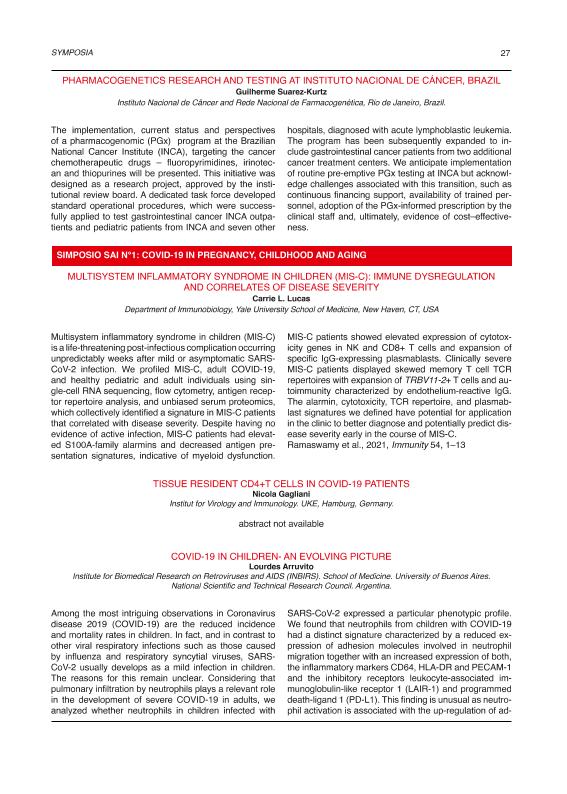Mostrar el registro sencillo del ítem
dc.contributor.author
Arruvito, Maria Lourdes

dc.contributor.other
Curino, Alejandro Carlos

dc.contributor.other
Maccioni, Mariana

dc.contributor.other
Schaiquevich, Paula Susana

dc.contributor.other
Duran, Hebe Alicia

dc.date.available
2022-03-17T15:20:58Z
dc.date.issued
2021
dc.identifier.citation
Covid-19 in children- An envolving picture; Annual Meeting of Bioscience Societies 2021: LXVI Annual Meeting of Sociedad Argentina de Investigación Clínica (SAIC), LXIX Annual Meeting of Sociedad Argentina de Inmunología(SAI), LIII Annual Meeting of Asociación Argentina de Farmacología Experimental (AAFE), XI Annual Meeting of Asociación Argentina de Nanomedicinas (NANOMED-Ar); Argentina; 2021; 1-2
dc.identifier.issn
1669-9106
dc.identifier.uri
http://hdl.handle.net/11336/153521
dc.description.abstract
Among the most intriguing observations in Coronavirus disease 2019 (COVID-19) is the reduced incidence and mortality in children. In fact, and in contrast to other viral respiratory infections such as those caused by influenza and respiratory syncytial virus, SARS-CoV-2 infection usually develop a mild course in children. The reasons for this remain unclear. Considering that pulmonary infiltration by neutrophils plays a relevant role in the development of severe COVID-19 in adults, we analyzed whether neutrophils in children infected with SARS-CoV-2 expressed a particular phenotypic profile. We found that neutrophils from children with COVID-19 express a distinct signature characterized by a reduced expression of adhesion molecules involved in neutrophil migration together with an increased expression of both, the inflammatory markers CD64, HLA-DR and PECAM-1 and the inhibitory receptors leukocyte-associated immunoglobulin-like receptor 1 (LAIR-1) and programmed death-ligand 1 (PD-L1). This finding is unusual as neutrophil activation is associated with the up-regulation of adhesion molecules as it was observed in adult COVID-19. We hypothesized that this particular signature might prevent neutrophil infiltration in the pulmonary capillaries thus providing protection against tissue injury in the children.While the course of SARS-CoV-2 infection in children is usually mild, some children develop severe COVID-19. It has been shown that severe disease in adults is associated with a delayed kinetic of antibody production. We also studied whether a defective antibody response could be associated with a more severe condition in children. We found that children with severe COVID-19 display a very poor and late antibody response against SARS-CoV-2. This weak antibody response was associated with a low frequency of circulating Follicular Helper T cells and a systemic inflammatory response revealed by high levels of inflammatory cytokines in plasma. Vaccines against COVID-19 have shown very high levels of safety and effectiveness. In countries that have led vaccination globally, such as Israel and the United Kingdom, the pandemic seems to hold first in the infection of children. In this scenario, it is urgent to characterize the factors determining the predisposition of some children to suffer severe COVID-19.
dc.format
application/pdf
dc.language.iso
eng
dc.publisher
Fundación Revista Medicina
dc.rights
info:eu-repo/semantics/openAccess
dc.rights.uri
https://creativecommons.org/licenses/by-nc-sa/2.5/ar/
dc.subject
COVID-19
dc.subject
Pediatria
dc.subject
Respuesta inmune
dc.subject
vacunas
dc.subject.classification
Inmunología

dc.subject.classification
Medicina Básica

dc.subject.classification
CIENCIAS MÉDICAS Y DE LA SALUD

dc.title
Covid-19 in children- An envolving picture
dc.type
info:eu-repo/semantics/publishedVersion
dc.type
info:eu-repo/semantics/conferenceObject
dc.type
info:ar-repo/semantics/documento de conferencia
dc.date.updated
2022-03-14T20:43:00Z
dc.journal.volume
81
dc.journal.pagination
1-2
dc.journal.pais
Argentina

dc.journal.ciudad
Buenos Aires
dc.description.fil
Fil: Arruvito, Maria Lourdes. Consejo Nacional de Investigaciones Científicas y Técnicas. Oficina de Coordinación Administrativa Houssay. Instituto de Investigaciones Biomédicas en Retrovirus y Sida. Universidad de Buenos Aires. Facultad de Medicina. Instituto de Investigaciones Biomédicas en Retrovirus y Sida; Argentina
dc.relation.alternativeid
info:eu-repo/semantics/altIdentifier/url/https://www.reunionbiociencias.com.ar/
dc.conicet.rol
Autor

dc.coverage
Nacional
dc.type.subtype
Reunión
dc.description.nombreEvento
Annual Meeting of Bioscience Societies 2021: LXVI Annual Meeting of Sociedad Argentina de Investigación Clínica (SAIC), LXIX Annual Meeting of Sociedad Argentina de Inmunología(SAI), LIII Annual Meeting of Asociación Argentina de Farmacología Experimental (AAFE), XI Annual Meeting of Asociación Argentina de Nanomedicinas (NANOMED-Ar)
dc.date.evento
2021-11-17
dc.description.paisEvento
Argentina

dc.type.publicacion
Journal
dc.description.institucionOrganizadora
Sociedad Argentina de Investigación Clínica
dc.description.institucionOrganizadora
Sociedad Argentina de Inmunología
dc.description.institucionOrganizadora
Asociación Argentina de Farmacología Experimental
dc.description.institucionOrganizadora
Asociación Argentina de Nanomedicina
dc.source.revista
Medicina (Buenos Aires)

dc.date.eventoHasta
2021-11-20
dc.type
Reunión
Archivos asociados
